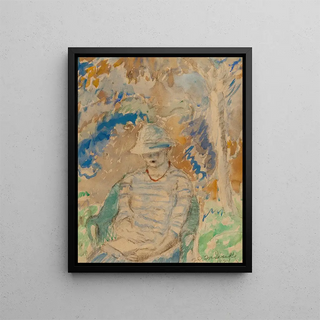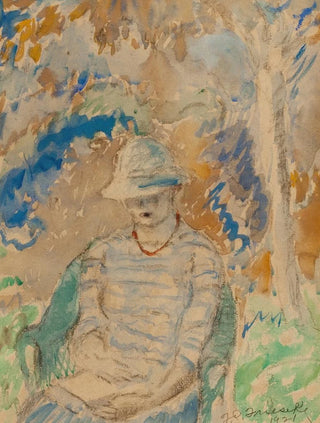Art print | Reading in the Garden - Frederick Carl Frieseke


View from behind

Frame (optional)
In the world of art, some works manage to capture the very essence of everyday life while evoking an atmosphere of dream and tranquility. "Reading in the Garden" by Frederick Carl Frieseke is one of those creations that transports the viewer into a universe where nature and intimacy meet. Painted in the early 20th century, this piece not only showcases Frieseke's exceptional talent but also his skill in capturing moments of serenity and contemplation. The scene depicts a woman immersed in reading, surrounded by the lush greenery of a garden, where light plays a crucial role, creating a dialogue between indoors and outdoors. This artwork invites a pause, a reflection on the beauty of simple moments, while highlighting the harmonious relationship between humans and their environment.
Style and uniqueness of the work
Frederick Carl Frieseke's style is deeply influenced by the Impressionist movement, but he distinguishes himself through a more personal and intimate approach. In "Reading in the Garden," vibrant colors and delicate brushstrokes evoke an atmosphere of lightness and softness. The composition, centered on the female figure, immediately draws the eye, while shades of green and blue create a soothing contrast with touches of golden light. Frieseke manages to capture the essence of natural light, transforming each element of the garden into a symphony of colors. The woman, absorbed in her reading, almost seems to merge with her environment, illustrating the idea that nature and art can coexist in perfect harmony. This painting is an ode to tranquility and the beauty of moments suspended in time, an invitation to contemplation.
The artist and his influence
Frederick Carl Frieseke, born in 1874, is an American artist who established himself on the international art scene thanks to his unique style and artistic vision. Trained at the École des Beaux-Arts in Paris, he was influenced by the great Impressionist masters while developing a signature that is entirely his own. His work is characterized by an exploration of themes such as light, color, and domestic life.

Matte finish

View from behind

Frame (optional)
In the world of art, some works manage to capture the very essence of everyday life while evoking an atmosphere of dream and tranquility. "Reading in the Garden" by Frederick Carl Frieseke is one of those creations that transports the viewer into a universe where nature and intimacy meet. Painted in the early 20th century, this piece not only showcases Frieseke's exceptional talent but also his skill in capturing moments of serenity and contemplation. The scene depicts a woman immersed in reading, surrounded by the lush greenery of a garden, where light plays a crucial role, creating a dialogue between indoors and outdoors. This artwork invites a pause, a reflection on the beauty of simple moments, while highlighting the harmonious relationship between humans and their environment.
Style and uniqueness of the work
Frederick Carl Frieseke's style is deeply influenced by the Impressionist movement, but he distinguishes himself through a more personal and intimate approach. In "Reading in the Garden," vibrant colors and delicate brushstrokes evoke an atmosphere of lightness and softness. The composition, centered on the female figure, immediately draws the eye, while shades of green and blue create a soothing contrast with touches of golden light. Frieseke manages to capture the essence of natural light, transforming each element of the garden into a symphony of colors. The woman, absorbed in her reading, almost seems to merge with her environment, illustrating the idea that nature and art can coexist in perfect harmony. This painting is an ode to tranquility and the beauty of moments suspended in time, an invitation to contemplation.
The artist and his influence
Frederick Carl Frieseke, born in 1874, is an American artist who established himself on the international art scene thanks to his unique style and artistic vision. Trained at the École des Beaux-Arts in Paris, he was influenced by the great Impressionist masters while developing a signature that is entirely his own. His work is characterized by an exploration of themes such as light, color, and domestic life.






